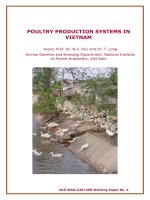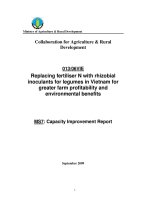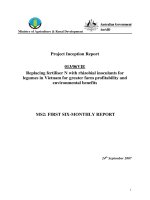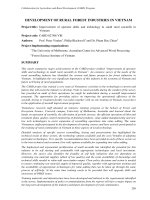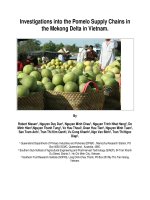Agricultural modernization in conjunction with rural development in Vietnam
Bạn đang xem bản rút gọn của tài liệu. Xem và tải ngay bản đầy đủ của tài liệu tại đây (54.5 KB, 8 trang )
Agricultural modernization in conjunction with rural development
in Vietnam
Nguyen Xuan Trach*
Hanoi University of Agriculture, Vietnam
Abstract
To meet a rapid growth of demand for agricultural products modernization of agriculture in
Vietnam is indispensable. That is because there are now important socio-economic
constraints to increasing agricultural production in the traditional mixed smallholder systems,
although they have been reasonably productive and inherently sustainable. However,
introduction of modern technologies in agricultural production for higher productivity may,
on the other hand, result in consequences that are not in line with sustainable development
targets such as alleviation of poverty, creation of jobs, more equitable life styles, protection
of the environment, and conservation of biodiversity. This warrants search for appropriate
ways of agricultural modernization coupled with sustainable rural development. The present
paper comes up with a conceptual framework for development of management, technical and
policy approaches toward appropriate modernization of agriculture without the dilemma
between unsustainable high productivity and low-productive sustainability. R & D
orientations are then proposed to achieve the targets of both agricultural modernization and
rural development in the country.
Key words: Agricultural modernization, rural development, productivity, sustainability
Introduction
Traditionally, in Vietnam agricultural production has been based on mixed smallholder
systems. In a low-income country, these integrated systems have considerable advantages
compared with specialized cropping or animal production in that although each of these
integral sub-systems may function independently, they are nevertheless complementary and
synergistic. The integration and synergism of the sub-systems can produce a greater output
than the sum of their individual effects. Such integrated crop-agricultural systems allow for
minimizing wastes through recycling, which in turn reduces the need for raw materials from
outside, minimizing risks for farmers. In addition, they can help to protect the environment
and conserve biodiversity owing to using indigenous inputs, which also require less agrochemicals. Greater use of indigenous knowledge and more complete use of rural labor in these
systems ensure relatively high productivity, income and access to goods and services of the
rural population. Thanks to these integrated farming systems, “if it were assessed in terms of
sustainable agriculture it (Vietnam) would be among the leaders” (Preston, 1995).
The time-tested integrated systems, which have often been developed over hundreds or
thousands of years, are reasonably productive and inherently sustainable. However, it should
be recognized that there are now important socio-economic constraints to increasing
agricultural production in such mixed smallholder systems (Ogle and Phuc, 1997). Especially,
they are now challenged due to declining farm size and raising consumer demand for
PDF created with pdfFactory Pro trial version www.pdffactory.com
agricultural products. As a result, modernization for intensive agricultural production is
indispensable because modernized intensive production systems can produce more outputs per
unit of land resource than the traditional systems. Actually, middle-scale agricultural farms
and large-scale agricultural production units have been recently developed in peri-urban areas,
satisfying an important part of the consumer demand in the big cities (Le Viet Ly, 2000).
Nevertheless, it is of increasing concern nowadays that undesirable ecological and sociological
consequences may result from modernization of agricultural production. The present paper is,
therefore, aimed to discuss possible negative impacts of inappropriate modernization of
agricultural production and then propose a conceptual framework and R & D orientations for
modernization of agricultural production without penalizing sustainable development of the
country.
Possible consequences of inappropriate modernization of agricultural
production
As experienced in many developing countries, although modernization of agricultural
production can bring more agricultural products per unit of resource, thus better meeting the
increasing demands for domestic consumption as well as export, imported modern
technologies for such intensive agricultural production have almost always failed to overcome
the constraints imposed on local farming systems or to meet the socio-economic requirements
of farmers (Sansoucy, 1997). The following consequences of introducing large-scale intensive
production systems with imported modern technologies are possible and should be taken into
account.
- Increased unemployment and impoverishment of rural people
An important question of concern is how modernization of agricultural production should be
undertaken in a densely populated country with the majority living in rural areas. In Vietnam
around 80% of the population live in rural areas and approximately 70% of these rely on
agriculture for their livelihoods. There is still a big problem of rural poverty which urgently
needs to be alleviated.
Modernization of agricultural production with use of technologies imported from developed
countries means minimum use of labor and maximum use of labor saving devices. Land
accumulation, which is a prerequisite for agricultural modernization in such a country with so
tattered lands, will make numerous farmers landless. By the same token, the concurrent
process of industrialization and urbanization will make the situation worse. Furthermore,
introduction of modern large-scale agricultural operations would lead to problems for
smallholder producers who cannot compete for available resources and markets (Ogle and
Phuc, 1997) and may not have the skills for the more sophisticated management which is
required (Preston, 1995). All of these will ultimately result in a reduction in rural employment
opportunities and easily turn the problem of rural unemployment into an even greater problem
of urban unemployment (Figure 1).
Therefore, modernized agricultural production may benefit a few capable producers at the
expense of the majority who will lose their shares in common resources, both tangible and
intangible, and job opportunities. Consequently, the disadvantaged people will be faced with
impoverishment, the gap between the few rich and the major poor will become larger and
larger, and social evils will become a heavy burden for the society. In the years to come the
2
PDF created with pdfFactory Pro trial version www.pdffactory.com
MODERNIZED
AGRICULTURE
INPUTS &
MARKET
COMPETITION
Land accumulation
labor saving technologies
challenge is to decrease rural poverty in rural areas as only a limited amount of people can be
absorbed into urban businesses. Clearly, modern intensive agricultural production models
imported from developed countries are sociologically unsustainable under the circumstances
of a developing country like Vietnam.
RURAL
UNEMPLOYMENT
SOCIAL
EVILS
URBAN
UNEMPLOYMENT
SOCIAL
PROBLEMS
-
TRADITIONAL
AGRICULTURE
IDUSTRIALIZATION
& URBANIZATION
POVERTY
INCOME GAP
Figure 1: Increased social problems due to inappropriate modernization of agricultural
production
- Increased economic risks
Intensive agricultural production systems based on imported technologies are also
economically unsustainable (Figure 2). The labor saving technologies would in turn require
the use of large amounts of fossil fuels. Two main factors that would lead to such intensive
agricultural production systems are high cost of labor and low cost of fossil fuels. This is not
the case nowadays in the era of so-called “peak oil”.
The economic efficacy of modern farms is first subjected to changes in price and availability
of inputs, to say nothing of difficulty marketing products in the changeable international
markets. The intensive farming systems will generally increase foreign exchange deficit due to
high imports. In addition, the producers need to have high management skills and technical
expertise, whereas the margins gained may be small. Another factor contributing to economic
risks for these intensive systems is the introduced exotic breeds of animals or crop varieties
being highly susceptible to diseases and vulnerable to hardship under unfavorable tropical
climate conditions. The dangers of introducing inappropriate imported technologies have been
well illustrated in the recent economic crisis in other South-East Asia countries. For example,
in Indonesia 80% of the poultry industry went bankrupt causing many problems of food
supplies and malnutrition (Orskov, 2001).
3
PDF created with pdfFactory Pro trial version www.pdffactory.com
IMPORTED
INPUTS
AGRICULTURAL
MODERNIZATION
IMPORTED
TECHNOLOGIES
LOCAL
INPUTS
EXTERNAL
DEPENDENCE
ECONOMIC
RISKS
FOSSIL FUEL
USE
Figure 2: Increased economic risks due to inappropriate modernization of agricultural
production
UNRECYCLED
WASTES
AGRICULTURAL
MODERNIZATION
BYPRODUCT
UTILIZATION
EXOTIC
GENETICS
POLLUTION
ENVIRONMENT
&
BIODIVERSITY
INDIGENOUS
GENETICS
Figure 3: Negative impacts of inappropriate modernization of animal production on the
environment and biodiversity
4
PDF created with pdfFactory Pro trial version www.pdffactory.com
- Negative impacts on the environment and biodiversity
Protection of the environment and conservation of biodiversity are of increasing concern
nowadays. That is because human activities are causing alarming levels of atmospheric
contamination, deforestation, erosion, soil and water pollution and loss of biodiversity, which
are all affecting people’s livelihood and health, and threatening sustainable development
(Preston, 1995). Modern large-scale industrial livestock units, for instance, easily lead to
problems to the environment and biodiversity (Figure 3). In such intensive production units
the high animal population will produce too much excreta while there are not enough
associated crops to recycle it. They will also result in a reduction in the numbers of indigenous
animals, which are highly tolerant to diseases and efficient in utilizing local feeds, especially
agricultural by-products and household leftovers.
Conceptual framework for agricultural modernization in line with rural
development
The above mentioned possible consequences of introducing intensive production systems with
inappropriate modern technologies imported from developed countries should imply that they
are not sustainable in social and ecological terms for Vietnam. Therefore, any strategies for
modernization of agricultural production in the country must keep balance between the
modernization targets and sustainable development targets (Figure 4).
AGRI. MODERNIZATION
TARGETS:
RURAL DEVELOPMENT
TARGETS:
• Increased productivity
• Increased income
• Increased economic growth
• Poverty reduction
• Food security
• Environmental protection
• Biodiversity conservation
• Increased jobs & income
• Social welfare & equitability
Figure 4: Needed balance between agricultural modernization targets and sustainable rural
development targets
5
PDF created with pdfFactory Pro trial version www.pdffactory.com
Modernization of agricultural production in Vietnam should thus be aimed at the following
integrated targets:
- Increased productivity without compromising ecological benefits and job
opportunities.
- Increased economic growth together with alleviation of rural poverty and
attainment of food security.
- Increased income of the producers coupled with improved social welfare and
equitability.
Putting all together, a conceptual framework for modernization and further improvement of
agricultural production in Vietnam to be able not only to meet the rapidly increasing demand
for agricultural products but also ensure sustainable development is recommended as follows
(Figure 5).
NATURAL
RESOURCES
Efficient management
& utilization
• Increased productivity
• Poverty reduction
• Food security
• Reasonable economic growth
AGRICULTURAL
MODERNIZATION
Appropriate
technical modernization
• Job creation
• Income generation
• Environmental protection
• Biodiversity conservation
SOCIO-ECONOMIC
ENVIRONMENTS
Sound
policies
• Equitable life styles
• Increased social welfare
Figure 5: A conceptual framework for modernization of agricultural production in line with rural
development in Vietnam
R & D orientations for agricultural modernization in line with sustainable
rural development
To obtain the above balanced targets, efforts to rationally modernize agricultural production
need to take into account the available natural resources as well as the socio-economic
environments. Appropriate technical modernization must be undertaken in line with efficient
management of natural resources and sound socio-economic policies. For that purpose,
research and development endeavors are needed and should be oriented to:
- Improving efficiency in the use and management of natural resources to optimize the
capacity of the local ecosystem to produce increased agricultural products;
- Matching genetic potentials of animals and crops with local resources, climate
conditions, and agricultural husbandry expertise;
6
PDF created with pdfFactory Pro trial version www.pdffactory.com
- Maximizing the use of indigenous knowledge and local labor;
- Minimizing wastes through recycling and improved utilization of byproducts to
reduce the need for external raw materials and help to protect the environment;
- Modernization of small-scale agricultural production which can create more job
opportunities;
- Developing technologies with farmer participation to ensure high levels of adoption
and sustainability.
- Developing modernized large-scale production together with improving smallholder
production;
- Increasing the value of agricultural production to smallholder producers by effective
processing and marketing of their products ;
- Developing sound socio-economic policies for better use of common resources and
fair commodity prices.
- Promoting rural industrialization together with civil and production services to absorb
most redundant labor resulted from agricultural modernization (Figure 6).
RURAL
INDUSTRIES
Modern technologies
Land accumulation
MODERNIZED
AGRICULTURE
TRADITIONAL
AGRICULTURE
Vocational training
REDUNDANT
LABOR
Vocational training
CIVIL SERVICES
Vocational training
Vocational training
URBAN
BUSINESSES
Figure 6: Use of redundant labor resulted from agricultural modernization
References
1. Le Viet Ly (2000). Development of a sustainable agricultural production system based on
the advantage of tropical agriculture. Proceedings of the workshop on “Making better use of
local feed resources”. January, 2000. SAREC-UAF. pp. 52-58.
2. Ogle, B. and Phuc, B.H.N. (1997). Sustainable intensive livestock-based systems in
Vietnam. IRDCurrent 14: 16-22.
7
PDF created with pdfFactory Pro trial version www.pdffactory.com
3. Orskov, E.R. (2001). Sustainable resources management and rural development in Vietnam.
Paper presented at the seminar on ruminant nutrition held in Hanoi on 12 January 2001 by
Vietnam Animal Husbandry Association.
4. Preston, T.R. (1995). Strategy for sustainable use of natural renewable resources:
constraints and opportunities. First FAO Electronic Conference on Tropical Feeds and
Feeding Systems.
/>5. Sansoucy, R. (1997). Livestock-a driving force for food security and sustainable
development. IRDCurrent 13/14: 4-11.
8
PDF created with pdfFactory Pro trial version www.pdffactory.com


